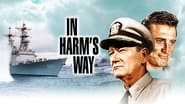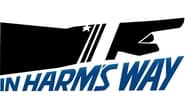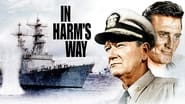Tracy Winters
Probably the worst war film set during Pearl Harbor.John 'The Duke' Wayne does his schtick as a military officer, this time as a Navy Captain affectionately known to his men as 'The Rock'. "He's all navy and nuthin but navy" spouts one guy while Wayne-- sorry, The Rock, throws around dusty dialogue like "this man's navy" and "get on the ball, I got a ship to run".By far, the most dim-witted thing that happens follows the attack on Pearl Harbor. As American soldiers are floating dead in the water and their ships are burning all around them on December 7, 1941, Wayne and Kirk Douglas give each other a goofy smirk and say, "Looks like we got ourselves a whole new gut-bustin' mutherluvin' war" as they saunter off to have a beer.Other golden moments include a navy ship captain and his chuckling buddies ditching fellow sailors who are in distress so they can save their own asses. Isn't that lovely? Sub-standard war movie, alternately silly and boring, but most of all long, with a wheel-barrow full of celebrities dumped on screen every few minutes.
inspectors71
which makes Otto Preminger's In Harm's Way even better. I've loved IHW for over four decades, mainly because of the straightforward, solid, and emotionally satisfying storytelling. I'll leave the synopsis of the movie to the other writers. Here, I just want to say thank you to all involved with this visually beautiful, patriotic morality tale of naval warfare in the Pacific Theater of World War II. There's something very satisfying with the combination of military history, political intrigue, love, lust-for-power, and Preminger's elegant use of black and white film. Bring aboard John Wayne at his most pensive and introspective, Kirk Douglas at his most dashing and tortured, Patricia Neal projecting a middle-aged sexiness that I couldn't even begin to appreciate the first time I saw IHW (1972), and a slew of great, great secondary performances, and the viewer may begin to get a little short of breath. How does one movie have so much going for it, and nobody's ever heard of it?Side note: It flopped at the box office. Oh, well.Even Jerry Goldsmith, a composer best known for Patton, gives IHW's score a richness that compliments the dreamy, creamy, and colorful cinematography. There are so many reasons to love In Harm's Way that a fan can and should forgive its many flaws. There are technical quibbles sprinkled throughout the film that make a nitpicker like me cringe, then shrug. And the most glaring flaw in the movie is the use of large models for the climactic sea battle between a Japanese force and Wayne's numerically inferior battle group. Critics have panned the whole movie for the non-CGI phoniness of the battle.The critics are wrong. Even Wayne and Douglas, who fought against the inclusion of the battle with Preminger, to know avail, were wrong. The battle gives In Harm's Way an "old school" feel, beyond the B&W and the fact that most of the actors and actresses and crew have passed on. In Harm's Way is my favorite war movie. Soap suds and slickeries and idiosyncrasies--and all those exploding car-length warships-- can't take away the fact that this is a very satisfying, well-acted, and grown- up story.
Edgar Allan Pooh
. . . must have been the most botched flick ever made about the infamous Japanese Sneak Attack which drew America into World War Two. As it turns out, there's at least one film lamer than that 2001 Josh Hartnett vehicle called IN HARM'S WAY. Some Bozo Director who specialized in making B-Movies about trashy trailer park murders concocts a phony baloney version of WWII's War in the Pacific which makes BATTLESHIP look authentic by way of comparison. In this bogus martial exercise, Emporer Hirohito's boys are defeated primarily due to alcoholic rapist Kirk Douglas' moment of rash remorse. Since Kirk's suicide reconnaissance flight would not have gotten off the ground had not Nurse Annalee honor-killed herself, SHE'S the one who should get the Medal for Winning WWII. Give John Wayne's son--lost on PT 108 1/2--an asterisk for helping to motivate his fiancée Annalee to off herself, and award one of those to Wayne's senior citizen squeeze Patricia O'Neal as well for dooming her naive young charge with nursery rhymes in lieu of sensible orders and supervision. Speaking of Patty, she and "The Duke" make extramarital sex look about as exciting as shuffleboard. Hopefully, John and Pat's final Hospital Ship trysting zone has such a game up on the deck, since that will be enough of a challenge for the pair now that John's down to one leg to stand on.
Robert J. Maxwell
James Bassett's novel was pretty retrograde for the mid 1960s. It endorsed every apple-pie value imaginable. Adulterers and rapists die. The Navy was good, but politicians, high-class Bostonian elites, public relations personnel, journalists, and rear echelon headline mongerers were condemned. On top of that the book was clumsily written. Everyone -- men and women alike -- seemed to speak with the same cadence and vocabulary. Cliché followed cliché. When -- Full speed ahead; damn the spoilers! -- when Rockwell Torrey loses a leg at the end of the story, he's ashamed to face his girl friend because he's "only half a man." I'm not making that up. And when, on the eve of battle, an officer confesses that he's scared to death, Wayne admits that he too is scared. We've seen that identical exchange dozens of times. In this case Wayne's deportment didn't convince me he was really scared. He seemed strung out behind 3 milligrams of Xanax.The novel could have been written with Hollywood in mind because it has all the audience appeal of any other commercial effort -- three (or maybe four) romantic relationships going on at once, bureaucratic intrigue with heroes and villains, and an opening sea battle and an even bigger climactic engagement.Wendell Mayes, the screenwriter, pulls all these threads together in a way that, while still leaving this a mediocre effort, improves on the book, if only by shortening it.John Wayne exudes relaxed authority, which is his forte. He could have walked through the part but he does a thoroughly professional job. Kirk Douglas is second in the credits but has a much smaller part as Wayne's competent but tormented assistant. Both men were aging visibly by this time in their careers and at times it seems that Douglas is wearing a Kirk Douglas mask, but Douglas at least gets the few humorous moments in the story.Brandon De Wilde was splendid as the little boy in "Shane" eleven years earlier, and fine as the naive teen in "Hud." Here, as a Wayne's estranged son, a young Harvard-educated PT boat officer, he's adequate but no more than that.Patricia Neal is Wayne's girl friend, a savvy but gentle nurse. She's no longer a glamorous kid either, but her face seems careworn and soft. She's a suitable mate for Wayne. Jill Haworth is the saucy young nurse who is engaged to De Wilde but tempts Douglas beyond the point of redemption. She's more figure than talent. There's a third romance between the heroic Tom Tryon and the achingly horny Paula Prentiss, but it's not clear why this narrative thread was left in the script. The intrigues and their dynamics are dazzling enough without it.The battles were done with models, as was usual at the time, and the special effects are okay for the period, but compare the contemporary "Sink the Bismarck" to see how it could have been more convincingly executed. That last engagement was a bit confusing because when ships are exploding, it's hard to tell one from another.Historically the whole affair is fiction. Well -- two real figures appear on the screen. Admiral Husband Kimmel (Franchot Tone) who got all the blame for the naval disaster at Pearl Harbor and whose head rolled, and Admiral Nimitz (Henry Fonda) who has two or three short scenes of no particular distinction.The climactic battle steals elements from Guadalcanal (if we don't stop the Japanese from finishing that airstrip, we're sunk), Surigao Strait (the Japanese are caught by mines and torpedo boats in a narrow channel during a night action), and Leyte Gulf (a super battleship and numerous escorts against a lesser fleet of American ships, with the Japanese turned away at the last minute by a display of American gallantry). Nice black-and-white photography.It's not a bad movie but rather strictly routine. There are no stand out performances because there are no opportunities for stand out performances. The script is too bland for that. Preminger does manage one actually shocking incident. It takes place in the officer's john, and involves Douglas slapping the evil-looking Patrick O'Neal several times across the face -- hard. Otherwise, it's by the numbers.
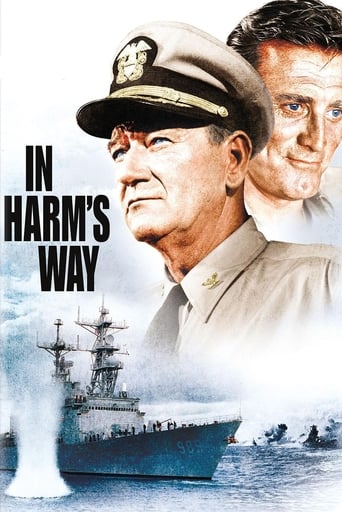
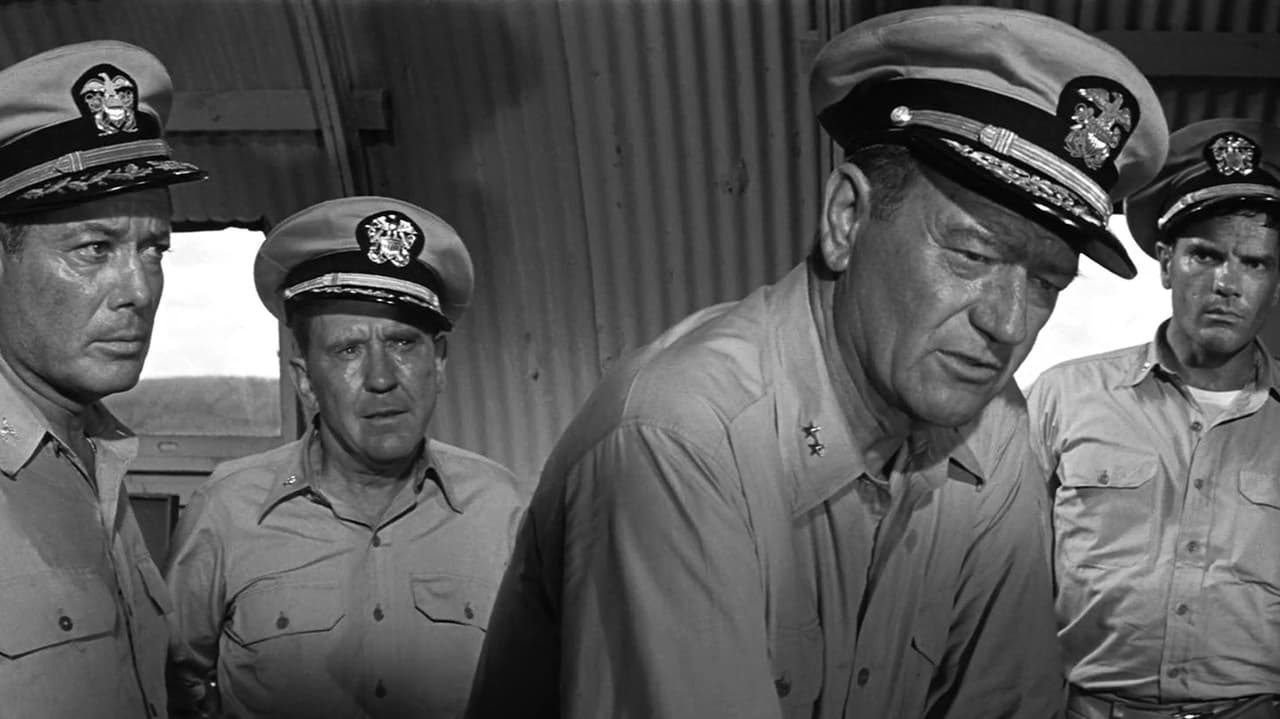

 AD
AD



